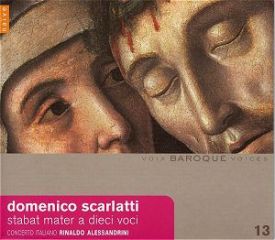Domenico Scarlatti: Stabat Mater - Missa Quatuor Vocum (1999)
Domenico Scarlatti: Stabat Mater - Missa Quatuor Vocum (1999)

Stabat Mater 1. Cujus animam gementem 4:55 2. Quis non posset 2:21 3. Eja Mater, fons amoris 2:16 4. Sancta mater, istud agas 1:50 5. Fac me vere tecum flere 0:50 6. Juxta crucem 1:55 7. Inflammatus 3:06 8. Fac ut animae 2:15 9. Amen 1:32 Missa quatuor vocum 10. Kyrie 6:21 11. Gloria 7:40 12. Credo 8:39 13. Sanctus 1:43 14. Benedictus 1:43 15. Agnus dei 3:19 Concerto Italiano: Elena Cecchi, Elisa Franzetti, Elisabetta Tiso, Rosa Dominguez (sopranos) Alessandro Carmignani, Fabian Schofrin (altos) Paolo Fanciullacci, Gianluca Ferrarini (tenors) Roberto Abbondanza, Sergio Foresti (basses) Andrea Damiani (archlute) Tiziano Bagnati (theorbo) Andrea Perugi (organ) Rinaldo Alessandrini - conductor
I have often read that Domenico Scarlatti, normally associated with keyboard sonatas, was an exceptionally fine composer of church music. This was especially in his younger years before embarking for Iberia. Consequently I purchased a recording of his Stabat Mater performed by the choir of Christchurch Cathedral Oxford (Hyperion CDA66182). Sadly I did not find the work to be especially arresting and hardly played it. I was therefore surprised and ‘bowled over’ as soon as I started to listen to track 1 of this re-issue of the Stabat Mater. The beauty, pain and intensity were immediately conveyed and I was instantly hooked. But why?
The Oxford performance is accompanied by organ but more importantly, although the singing is committed and excellent, the recording is unfocused and distant. Most importantly the choir sing the wondrous opening and indeed some of the movements, especially the first, as if it’s a ‘wash-day’ evensong and the Dean needs to get back early for his tea. It all seems so uninvolving, unemotional and - sorry to say - so very British. Nevertheless I was somewhat surprised that the Oxford performance takes, in the end, four minutes longer than Concerto Italiano, who are anyway, everything that Oxford is not. The work was written, it is generally assumed, for just ten singers. Here we have just ten singers. They are accompanied by archlute, theorbo and organ and they sing with fervour and total conviction. The tempi are slower and every word passionately expressed. The recording aids the work by being close as if in a private space. The madrigalian quality of the counterpoint is allowed its head. Juicy harmonies in the opening movement, in the mystic ‘Quando corpus’ and in the ‘Sancta Mater’, are particularly memorable.
The dating of the work is rather a puzzle. There is a Stabat Mater by his father Alessandro which can fairly easily be dated 1708-17. It is scored for vocal duet, violin, cello and continuo. There is also an especially well known example written by Pergolesi in the last year of his life: 1736. Domenico’s ten part version seems to challenge both of the others but also sets itself back into the early baroque and even into the renaissance. The text, which may be by Jacopone da Todi (d. 1306), is a twenty strophe poem written from the point view of Mary at the foot of the cross. The women’s voices of Alessandro and of Pergolesi are entirely appropriate. Domenico divides the text into ten sections, the last being a short but extraordinarily polyphonic A-men. Incidentally his father’s, much longer setting, is divided into eighteen sections. Variety is achieved through tempo and by differing vocal combinations. For example the first movement is tutti, the second ‘cujus animam gementem’ is slightly faster. The third begins homophonically to make a contrast with the intense polyphony of the first movements - I found myself thinking of Monteverdi madrigals. The fourth ‘Eja Mater’ begins in a higher register and is faster again. Not always are all ten parts employed. I could go on but I’m sure that you get the idea.
The Four-part Mass begins solemnly and is given the same instrumental support. Generally its mood, in this reflective performance, even in the Gloria is more contemplative than overtly joyous. Again, everything is so very sensitive, thoughtful and beautifully done. Tempi are contrasted within the longer movements dependent on text, for instance for the ‘Et Incarnatus’ of the Credo. The three-fold Agnus dei has simple polyphony with luscious suspensions and ends the work with a noble expression of grief and faith combined.
Roberto Pagano tells us clearly in the booklet notes that dating the Mass, like the Stabat Mater, is difficult which is why I have not put dates at the head of the review. The mass may have been written for the Spanish royal court but it was certainly copied there in 1754. Yet it may be quite an early work.
This disc was originally released to acclaim in 1999 and has recently been re-issued at mid-price. It is in direct competition not only with the Oxford recording mentioned above, but also with two more recent recordings. I have heard extracts from both: on Ricercar (RIC 258) with the ensemble Vox Luminis, the Stabat Mater coupled with the Missa Brevis and some motets and on Naxos (8.570382) with the Immortal Bach Ensemble coupled with the Salve Regina and the less arresting Te Deum. Both discs are beautifully and passionately performed and the recordings are not so ‘in your face’ as this Naïve coupling. Nevertheless, I like the ‘sound’ of Concerto Italiano. I like their voices and commitment and will put them happily on my shelf. I might well put Lux Luminis there as well if there’s room and indeed keep the Oxford performance. There is always room for new interpretations of great music. And, oh yes, the Stabat Mater of Domenico Scarlatti may not be as well known as Pergolesi but I do believe it to be a masterwork. ---Gary Higginson, musicweb-international.com
download: uploaded yandex 4shared mediafire solidfiles mega zalivalka filecloudio anonfiles oboom
Zmieniony (Czwartek, 24 Kwiecień 2014 14:55)








